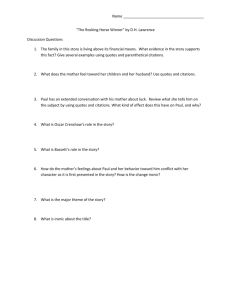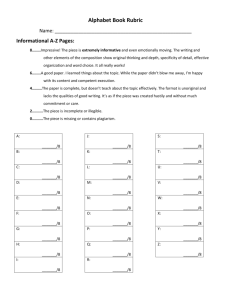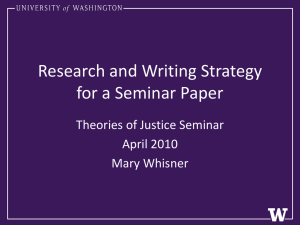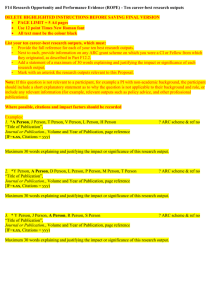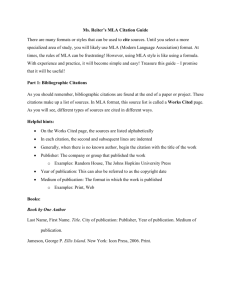References Harvard
advertisement
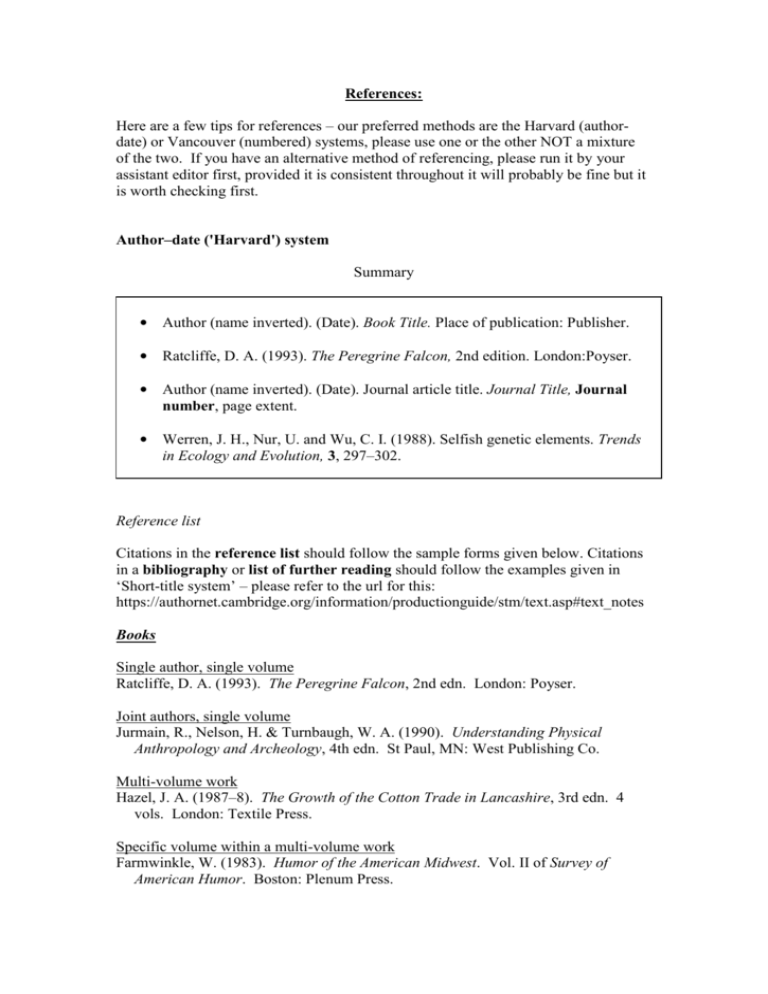
References:
Here are a few tips for references – our preferred methods are the Harvard (authordate) or Vancouver (numbered) systems, please use one or the other NOT a mixture
of the two. If you have an alternative method of referencing, please run it by your
assistant editor first, provided it is consistent throughout it will probably be fine but it
is worth checking first.
Author–date ('Harvard') system
Summary
• Author (name inverted). (Date). Book Title. Place of publication: Publisher.
• Ratcliffe, D. A. (1993). The Peregrine Falcon, 2nd edition. London:Poyser.
• Author (name inverted). (Date). Journal article title. Journal Title, Journal
number, page extent.
• Werren, J. H., Nur, U. and Wu, C. I. (1988). Selfish genetic elements. Trends
in Ecology and Evolution, 3, 297–302.
Reference list
Citations in the reference list should follow the sample forms given below. Citations
in a bibliography or list of further reading should follow the examples given in
‘Short-title system’ – please refer to the url for this:
https://authornet.cambridge.org/information/productionguide/stm/text.asp#text_notes
Books
Single author, single volume
Ratcliffe, D. A. (1993). The Peregrine Falcon, 2nd edn. London: Poyser.
Joint authors, single volume
Jurmain, R., Nelson, H. & Turnbaugh, W. A. (1990). Understanding Physical
Anthropology and Archeology, 4th edn. St Paul, MN: West Publishing Co.
Multi-volume work
Hazel, J. A. (1987–8). The Growth of the Cotton Trade in Lancashire, 3rd edn. 4
vols. London: Textile Press.
Specific volume within a multi-volume work
Farmwinkle, W. (1983). Humor of the American Midwest. Vol. II of Survey of
American Humor. Boston: Plenum Press.
Book in a series
Wolf, T. H. (1938). The Effects of Praise and Competition on the Persisting Behavior
of Kindergarten Children. Child Welfare Monograph Series, 15. Minneapolis:
University of Minnesota Press.
Journal articles
Werren, J. H., Nur, U. and Wu, C.-I. (1988). Selfish genetic elements. Trends in
Ecology and Evolution, 3, 297–302.
Trimble, S. W. (1997). Streambank fish-shelter structures help stabilize tributary
streams in Wisconsin. Environmental Geology, 32(3), 230–4.
Chapters in edited books
Simmons, N. M. (1980). Behaviour. In The Desert Bighorn, ed. G. Monson and L.
Summer. Tucson, AZ: University of Arizona Press, pp. 124–44.
or
Simmons, N. M. (1980). Behaviour. In G. Monson and L. Summer, eds., The Desert
Bighorn. Tucson, AZ: University of Arizona Press, pp. 124–44.
Unpublished dissertations and theses
Williamson, D. K. (1997). Primate socioecology: the development of a conceptual
model for the early hominids. Unpublished Ph.D. thesis, University College
London.
Technical reports
Philip Morris Inc. (1981). Optical Perforating Apparatus and System, European
patent application 0021165 A1. 1981–01–07.
Works by a single author should be listed before those co-written with others.
Joint works may be ordered in one of three ways. Use one system throughout:
Where a work has six or more authors, the first three only should be given,
followed by et al.
Works by the same author(s) in the same year should be distinguished by using
lower-case letters (1997a, 1997b etc., not 1997, 1997a…).
Text citations
Give the author's surname, date of publication and, if required, a page number,
e.g. (Smith, 1998: 20) or (Smith, 1998, p. 20).
An ampersand may be used in citations referring to two or more authors, but this
should be restricted to the parenthesised citation itself, and not to mentions of the
authors in text, e.g.:
‘One useful work (Smith & Jones 2004)…’
but
‘The work by Smith and Jones (1996)…’
Several citations together should be listed in either date order or alphabetical
order, but not a mixture.
Citations to works with two authors should give both names – use either 'and' or
'&' but not a mixture.
Citations to works with three authors can either (1) give all three names the first
time, and thereafter use et al.; (2) give all three names for every citation; or (3) use
et al. throughout.
Citations to works with four or more authors should use et al. throughout.
Do not use ibid. with the author–date system.
Numbered ('Vancouver') system
Summary
• Numbers should appear in text as [1] or1
• Date comes at the end of the reference
• [number] Author name, Book Title. (Place of publication: publisher, date).
• [1] D. A. Ratcliffe, The Peregrine Falcon, (London:Powser, 1993).
Numbers should appear in text as non-superscript numbers in square brackets
(superscript numbers without brackets are acceptable), preceding punctuation.
Where possible without losing clarity, the number should be placed at the end of a
sentence or before an obvious break in punctuation.
Each chapter should have its own reference list, and references should be
numbered in a fresh sequence within each chapter, in the order in which they are
cited in the text. If the same work is cited in more than one chapter it should be
included in the reference list for each chapter in which it appears.
Names should not be inverted. The publication date should appear last for books,
and preceding the page numbers for journal articles and chapters in edited
volumes.
Books
1. D. A. Ratcliffe, The Peregrine Falcon, 2nd edn (London: Poyser, 1993).
2. R. Jurmain, H. Nelson & W. A. Turnbaugh, Understanding Physical Anthropology
and Archeology, 4th edn (St Paul, MN: West Publishing Co., 1990).
3. J. A. Hazel, The Growth of the Cotton Trade in Lancashire, 3rd edn. 4 vols.
(London: Textile Press, 1987–8).
4. Wolf, T. H. (1938). The Effects of Praise and Competition on the Persisting
Behavior of Kindergarten Children. Child Welfare Monograph Series, 15
(Minneapolis: University of Minnesota Press, 1938).
Journal articles
1. J. H. Werren, U. Nur and C.-I. Wu, Selfish genetic elements. Trends in Ecology
and Evolution, 3 (1988), 297–302.
2. S. W. Trimble, Streambank fish-shelter structures help stabilize tributary streams
in Wisconsin. Environmental Geology, 32:3 (1997), 230–4.
Chapters in edited books
1. N. M. Simmons, Behaviour. In The Desert Bighorn, ed. G. Monson and L.
Summer. (Tucson, AZ: University of Arizona Press, 1980), pp. 124–44.
or
2. N. M. Simmons, Behaviour. In G. Monson and L. Summer, eds., The Desert
Bighorn (Tucson, AZ: University of Arizona Press, 1980), pp. 124–44.
Unpublished dissertations and theses
1. D. K. Williamson, Primate socioecology: the development of a conceptual model
for the early hominids. Unpublished Ph.D. thesis, University College London
(1997).
Technical reports
1. Philip Morris Inc., Optical Perforating Apparatus and System, European patent
application 0021165 A1. 1981–01–07.
General formatting of references using either system:
A References section must contain only works that are cited in the text, in
conjunction with the author–date (Harvard) OR numbered (Vancouver) system.
A Bibliography can contain additional material, not cited directly in the text. The
References and Bibliography sections should be kept separate. Books using the
short-title system can only have a bibliography.
All published works cited in the text (including sources for figures and tables)
must be included in one alphabetical list of references at the end of the book, or at
the end of chapters.
Every reference should be complete, giving authors' names and initials, date and
for books: book title, publisher's name and/or place of publication;
for journals: article title, journal title, volume number, issue number (if
appropriate), first and last page numbers;
for chapters in books: book title, editors (with initials), place of publication and/or
place of publication, first and last page numbers.
Book and journal titles must be in maximum capitals, italicised. Journal titles
may be either in full or abbreviated, but should all be treated the same way
throughout. Journal abbreviations should be those recommended by Chemical
Abstracts and the Index medicus.
Journal volume numbers should be bold.
Chapter and article titles should be in minimum capitals, roman, and may or may
not be enclosed in inverted commas.
Page ranges for chapters may or may not include ‘pp.’. Page ranges for journal
articles should never include ‘pp.’.
Either 'and' or '&' may be used between author names, but treatment should be
consistent.
If either the place of publication or publisher name is omitted, it should be done so
consistently. If both are given, place should precede publisher.
Punctuation in references and bibliography should be made consistent to the
author's most frequent usage, but note the following points:
Title and subtitle should be separated by a colon. Avoid more than one colon
in a title, separating the title and subtitle. If there is more than one, change
one into an en-dash or full stop. E.g.: Stargazing: A Guide. How to Build
Your Own Telescope.
In citations of chapters in edited books, avoid a colon after 'In'.
In an alphabetical list of references or bibliography, the first author name for
each citation must be inverted. Second and subsequent author names may be
inverted or not, but should be treated consistently.
Personal communications and unpublished data should be cited in full in the
text, and should not be included in the reference list (e.g. R. A. Smith,
personal communication, 1993). Forthcoming works should be included in the
reference list only if they have been accepted for publication. They should be
listed as ‘in press’ and updated when you see the proofs. Works that have not
yet been accepted (e.g. submitted, in review) should not be in the reference
list; they should be cited in the text as unpublished data or personal
communications. However, dissertations, theses and technical reports are an
exception, and are listed in the following sections (pp. 11, 14, 15–16).



